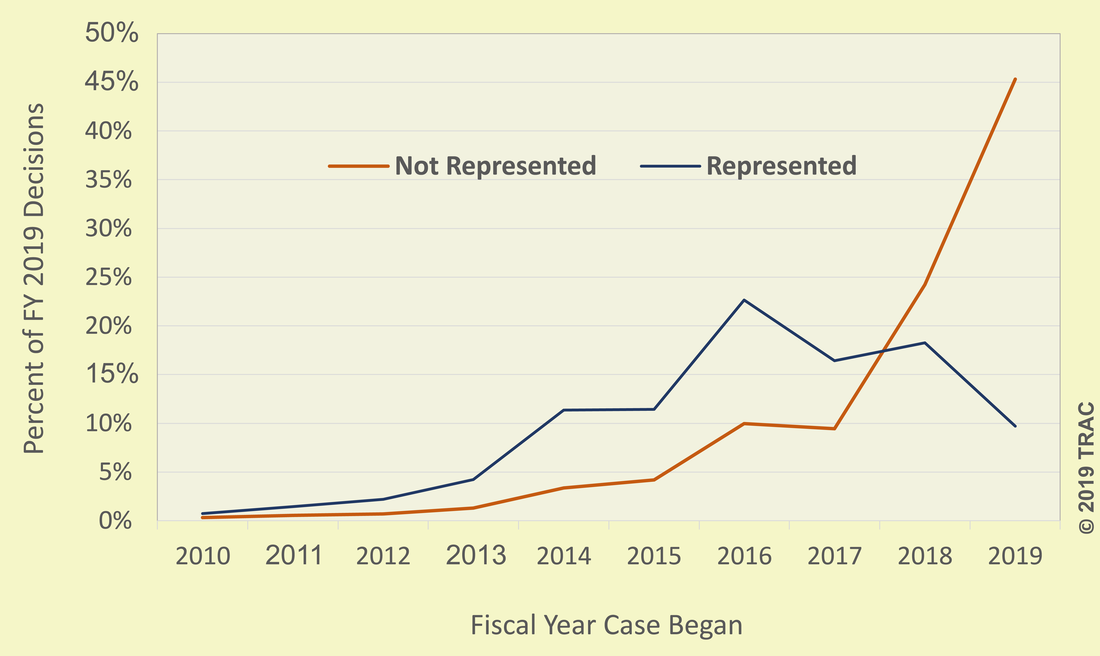 Immigration judges decided a record number of asylum cases in FY 2019. This past year judges decided 67,406 asylum cases, nearly two-and-a-half times the number from five years ago when judges decided 19,779 asylum cases. Asylum decisions also make up an increasing proportion of the Immigration Court's workload. Nearly one in four cases (22.6%) that judges decided were asylum claims in FY 2019, up from one in ten (10.7%) back in FY 2014. The number of immigrants who have been granted asylum more than doubled from 9,684 in FY 2014 to 19,831 in FY 2019. However, the number of immigrants who have been denied asylum or other relief grew even faster from 9,716 immigrants to 46,735 over the same time period. Six-nine percent (69%) of asylum seekers were denied asylum or other relief in 2019. See Figure 1 Figure 1. Immigration Court Asylum Decisions by Outcome, 2001 - 2019  Wait Times, Representation, and Denial Rates Overall, asylum applicants waited on average 1,030 days - or nearly three years - for their cases to be decided. But many asylum applicants waited even longer: a quarter of applicants waited 1,421 days, or nearly four years, for their asylum decision. Not surprisingly, applicants who were not represented by an attorney and thus less able to present an effective case received a faster decision than those applicants who did have an attorney. Figure 2 compares represented and non-represented asylum cases. Although all of the cases included in the graph were concluded in FY 2019, the graph shows the year each case began, which provides insight into the impact attorney representation plays on the speed of asylum cases. For instance, nearly half (45.3%) of the unrepresented asylum cases that began in 2019 have already been decided. In contrast, less than one in ten (9.7%) of the represented asylum cases that began in 2019 have been decided. Figure 2. 2019 Asylum Decisions by When Case Began  Access to an attorney also impacts the outcome of asylum cases. Only 16 percent of unrepresented asylum applicants received asylum or other forms of deportation relief. In contrast, twice the proportion (33%) of asylum applicants with an attorney received asylum or other relief. Asylum Decisions by NationalityMore Chinese nationals were granted asylum than any other nationality. Immigration judges granted asylum to 3,623 Chinese nationals in FY 2019. Despite fewer applicants compared to some other nationalities, a relatively low denial rate pushed their numbers to the top of the list. Chinese applicants were denied just 25 percent of the time compared with a 69 percent denial rate for asylum seekers generally. El Salvadorian nationals were granted asylum in 2,419 cases, and Indian nationals were granted asylum in 2,006 cases. Guatemala and Honduras had the fourth and fifth highest totals. Asylum seekers from Mexico, Cuba, Cameroon, Nepal, and Venezuela comprised the rest of the top ten nationalities receiving asylum grants during FY 2019. See Figure 3. Figure 3. Top 10 Nationalities Granted Asylum in 2019  Recent Trends Under President Trump Organized efforts across the country to provide pro bono legal representation resulted in increasing rates of representation for asylum seekers. Despite the very large jump in asylum cases in FY 2019, representation rates continued to rise modestly. During FY 2019, 84.7 percent of cases with asylum decisions had representation continuing the rise from 76.2 percent five years ago, 77.9 percent two years ago, and 83.8 percent one year ago. With rare exception, asylum seekers whose cases were decided in FY 2019 also showed up for every court hearing. This was true even though four out of five immigrants were not detained or had been previously released from ICE custody. In fact, among non-detained asylum seekers, 99 out of 100 (98.7%) attended all their court hearings. While Figure 1 shows a fairly steady rise in asylum denial rates since FY 2015, the month-by month picture gives a more nuanced impression. Against a backdrop of natural month-to- month variability, Figure 4 shows that there were periods of relative increase followed by stretches where rates showed little average gain. The switch to a purple line from blue shown in Figure 4 marks where President Trump assumed office following President Obama. The graph indicates that asylum denial rates rose during the initial months of the Trump Administration, but stabilized shortly thereafter. Starting in June 2018, however, denials began climbing again after former Attorney General Sessions strictly limited the grounds on which immigration judges could grant asylum. Sessions unilaterally restricted the legal basis for asylum for Central American women and children fleeing from gang and domestic violence. The unusually high denial rate in January 2019 occurred during the federal government shutdown when the only asylum cases judges heard were for detained immigrants who were often unrepresented. Figure 4. Percent of Immigration Court Asylum Decisions Denied September 2015 - September 2019 Drilling Deeper Into Asylum Data
Users can drill in to examine, month-by-month, asylum decisions by court, hearing location, nationality, custody, representation status and more. The Asylum Decision app has been updated to cover every Immigration Court asylum decision from October 2000 through November 2019.
0 Comments
Leave a Reply. |
HISTORY
April 2024
Categories |
© Walk 4 Change. All rights reserved.


 RSS Feed
RSS Feed